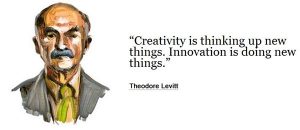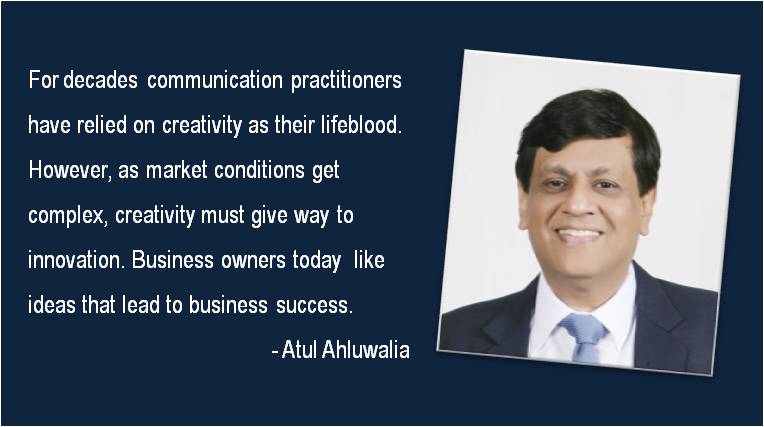
This quote, by one of the most disruptive management visionary of our times illuminates the core premise of our discussion. While innovation arises from creativity, and is, therefore, creative at its inception, all that is creative is not essentially innovative.
A simple example may help substantiate this proposition. Look at the best advertising campaigns. The stars at Cannes will win hearts and be toasts of town, shining instances of outputs of the best creative geniuses. However, not all result in real substantive business outcomes for the products/services advertised. On the other hand, a Tesla car, an Intel chip, the UBER business model at work, why, even the internal combustion engine for that matter, are all compelling proof points of innovation.
A lot of confusion and lack of clarity between the closely-linked notions of innovation and creativity lie at the root of many of us mistaking one for the other. Innovation solves a problem. Creativity recognizes the big picture and suggest contours to address the problem. Here, the constructs of invention also need mention.
Creativity germinates from imagination. It is the first step of the process. However, it can stay in the domain of ideas, and not really lead to a concrete product or process. Invention on the other hand is the physical form of a new idea or a concept. This is the typical eureka moment, which gives birth to something unique, and not just incrementally different. Inventions are patentable as they are easily identifiable.
Innovation, is the application of creativity or invention to make them meaningful for the larger society. It leads to new products, services or even new businesses. When a creative idea or invention is brought to life in a way that it creates value for the business organisation, government, and society it evolves into an innovation. Innovations are not patentable, and if they are good, competitors emulate them quickly without any restrictions.
Innovation or creativity
Let’s take a few examples to help us better appreciate the concepts. Lego was founded in 1932 by Ole Kirk Kristiansen. He was initially a failed carpenter who, thought of doing something else—make wooden toys. After Kristiansen passed away, ownership of the company went to his son, Kjeld Kirk Kristiansen. Brick-toy manufacturing was launched in 1958, giving the company more ways to compete and opening the door to unlimited building capabilities. A good example of how a pure creative process led to other things, and the implementation of an idea on such a scale that today Lego is the legend that it is.
There is no denying that creativity is the driving force behind innovation. But, the leap from idea to action is very critical for innovation to take place, and, succeed. The domain of imagination is the playground of creativity. Today, companies like Google and Tesla, or Amazon and Apple emphasize deeply on creative freedom. In fact, the capability of dreaming unfettered lies at the core of many of these giant’s organisational DNA. Since ‘creativity is the ability to conceive something unpredictable, original and unique’, it goes without saying that innovation takes the next step and makes the idea implementable. Therefore, not all ideas in these companies are worked on. Only those that make business sense, and which are seen to bring and add value are taken up and worked on further. The Google Labs is a good instance of how innovation is like a filter and a whetstone to creative flowering.
India has been a hotbed of innovations which uniquely harness the distinctiveness of the market. For example, cash-on-delivery mode of payment is one innovation which propelled the e-commerce business to explosive proportions. Similarly, making data dirt cheap and a common man’s consumption item has been an innovation which made Jio redefine the construct of the Indian telecom market. Before Jio data was sold at a premium as compared to voice calls by the legacy telecom operators. Jio has opened the market for mass content consumption.
The frugal Indian innovation has a different name: Jugaad. It is the simplest manifestation of creative implementation. The application of a washing machine to cream extraction from milk by the farmers in Punjab; the easy mechanisation of a horse carriage by installing a diesel generator; the clay refrigerator, etc. are all illustrations of creativity being transformed into value.
Here, it is important to keep in mind that creativity, which is not innovative today, may yet be something that evolves to something valuable in the future. Michelangelo and the other renaissance greats are testimony to this. The flying machine as drawn by Michelangelo is a before-time creative outburst which had to wait 350 years for fruition! Innovation is truly the positive adaptive mutation of creativity. And, sometimes, it can take time.
Communications’ verdict
Communication practitioners for decades have relied on creativity as their lifeblood. There has been a big demand for creative professionals. However, as market conditions get more complex, creativity must give way to innovation, as business owners would like ideas that lead to business success. This is where communicators need to learn from businesses on how by encouraging risk-taking they are able to create disruption and success.
For more conversations around Innovation (if you are an in-house communications professional), attend the Innovation First Communication Conclave in Gurgaon on Wednesday, March 14th, 2018.
The views expressed here are that of the author and do not necessarily reflect that of Reputation Today.



Be the first to comment on "All Innovation is Creative, but all that is Creative is not necessarily Innovative"